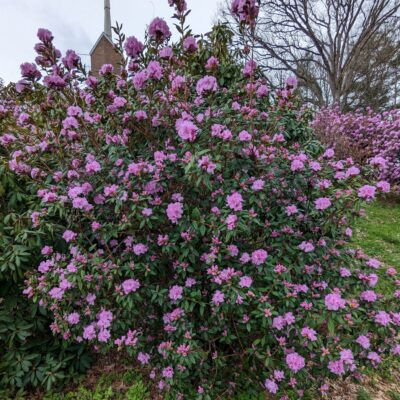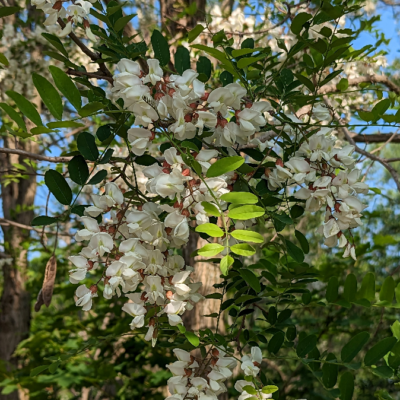A season of the year is a division based on changes in daylength, temperature and/or ecology. The northern hemisphere experiences the most sunlight the months of May, June, and July. However, due to seasonal lag, the warmest months are June, July and August. Seasonal lag means the average air temperature lags behind thermal insolation (length of time of solar radiation) by approximately one month. The seasons hold special significance for agriculture, horticulture and gardening to determine optimal planting and harvest times.
Meteorologists recognize four seasons, each of which are 3 months long: spring, summer, autumn (fall) and winter.
Astronomically, the seasons are based on daylength and not temperature. Daylength is the signal for plant growth, reproduction and onset of dormancy. The first day of each season varies on account that the earth’s rotation around the sun is not precisely 365 days. To adjust for this, a day is added to February (the 29th) every four years.
Spring
The first day of spring (in the northern hemisphere) therefore can be from March 19th to the 21st. At the spring or vernal equinox, day and night are equal (12 hours each).
By ecological reckoning, the onset of spring is not dictated by calendar dates. Rather, it is determined by phenological indicators such as budburst, flowering and animal activity.
Spring and springtime refer to a season of renewal and rebirth, when plant growth begins again and days warm. Daylength increases until the summer solstice, the longest day of the year.
Summer
The summer solstice occurs when one of the earths poles has its maximum tilt toward the sun. In the northern hemisphere, this occurs on the 20th or 21st of June. In temperate zones, the length of daylight is around 15 hours.
Autumn
In northern regions, Autumn starts with the September equinox (21st to the 24th of September). As ambient daytime and nighttime temperatures cool, trees change color and shed their leaves. Before the 16th century, the season was referred to as harvest in European culture. Today in the US, we celebrate harvest in the form of the Thanksgiving feast.
Winter
The winter solstice occurs when one of the earths pole tilts away from the sun. It is the coldest season of the year in temperate regions. By meteorological reckoning, winter is the three coldest months of the year, corresponding to December, January and February in the northern hemisphere. The winter solstice occurs on the shortest day and the longest night. By astronomical reckoning, the winter solstice occurs between the 20th and 22nd of December in the northern hemisphere.
Ecological reckoning differs by avoiding the use of fixed calendar dates. This period is referred to the hibernal period by ecologists. The hibernal season coincides with the dormancy period. To survive the harshness of winter, animals have adapted strategies for survival including migration (birds, butterflies), hibernation (gophers, frogs, snakes, bats), and food storage (skunks, beavers, squirrels, raccoons).
Non-Calendar Based Reckoning
From an ecological point of view, a season is a period of the year in which only certain floral or animal events occur. Ecological reckoning has six periods: prevernal, vernal, aestival, serotinal, autumnal, and hibernal.
- Prevernal (early or pre-spring) begins February to March. Buds of trees begin to swell, some migrating birds return
- Vernal (spring) begins late March to April. Trees produce new leaves, birds build nests and mate
- Aestival (summer) begins in June in most temperate climates. Trees fully leaf out; birds hatch and raise offspring.
- Serotinal (late summer) begins mid to late August. Trees begin to turn color at higher elevations. Young birds reach maturity and prepare for migration. Harvest begins in early September.
- Autumnal (autumn) begins mid to late September. Trees at peak color, leaves fall. Birds migrate to winter habitats.
- Hibernal (winter) begins November to December. Deciduous trees are bare, fallen leaves begin to decay. Migrating birds settle in winter habitats.
From this perspective, we are in fact making observations of phenological events.
Phenology
Phenology is the study of biological events and how they are influenced by season and climatic factors. Examples include budburst, flowering, the migration of birds and butterflies. Because many such phenomena are influenced by fluctuations in temperature, the observation and recording of biological events is a useful tool to growers in the face of a changing climate.
Most species interact with each other in natural systems which include interactions between plant-plant, animal-animal, predator-prey, and plant-animal. Species experience changes in the timing of their development due to warming temperatures. This could lead to species interaction mismatches. For example, if a plant flowers earlier than normal, but its pollinator has yet to emerge, a mismatch occurs, to the potential detriment of each.
Growing Degree Day
Growing degree days (GDD) is a phenological tool used by horticulturists, gardeners and farmers to predict plant and animal development rates such as bloom date, pollinator emergence and harvest date. Baseline temperatures used for calculating GDD are 41F for cool season crops and 50F for warm season crops and most insects. GDD is calculated by recording the temperature change over a 24-hour period less a base temperature of 50 F. The formula is:
GDD = Tmax + Tmin/2 – 50F
The following table lists some key species and their bloom date based on GDD. Note that the month indicated will vary based on your location.
Development of Some Common Species
| Common Name | Latin Name | Full Bloom at GDD base 50F | Month |
| Red maple | Acer rubrum | 1-49 | March to E. April |
| Flowering quince | Chaenomeles japonica | 1-49 | March to E. April |
| Star Magnolia | Magnolia stellata | 1-49 | March to E. April |
| Saucer Magnolia | Magnolia soulangeana | 1-49 | March to E. April |
| Forsythia | Forsythia spp. | 50-99 | L. March to L. April |
| PJM Rhododendron | Rhododendron PJM | 50-99 | L. March to L. April |
| Shadbush | Amelanchier canadensis | 100-149 | L. April to E. May |
| Redbud | Cercis canadensis | 100-149 | L. April to E. May |
| Crabapple | Malus spp. | 100-149 | L. April to E. May |
| Dogwood | Cornus florida | 150-199 | May |
| Lilac | Syringa vulgaris | 249-299 | May to June |
| Black locust | Robinia pseudoacacia | 300-399 | L. May to June |
| Multiflora rose | Rosa multiflora | 400-499 | L. May to June |
| Mountain laurel | Kalmia latifolia | 600-699 | June |
| Elderberry | Sambucus canadensis | 800-999 | L. June to E. July |
| Mimosa | Albizzia julibrissin | 1000-1199 | July |
| Sumac | Rhus typhina | 1000-1199 | July |
| Butterfly bush | Buddleia davidii | 1200-1399 | July |
| Sweet Pepperbush | Clethra alnifolia | 1400-1699 | L. July to E. August |
| Rose-of Sharon | Hibiscus syriacus | 1400-1699 | L. July to E. August |
| Tree of Heaven (seed color) | Ailanthus altissima | 1700-1999 | August |
| Franklinia | Franklinia alatamaha | 2000-2399 | August to September |
Flowering Quince, Star Magnolia, PJM Rhododendron, Forest Pansy Redbud, Pink Flowering Dogwood, Black Locust
The Almanac
The earliest almanacs were calendars or records that included agricultural, astronomical and meteorological data. The first almanac printed in the thirteen colonies was in 1639. The Boston area became the first to publish an annual almanac followed by Philadelphia early in the 18th century, most notably by Benjamin Franklin. His Poor Richards Almanack was published annually from 1732 to 1758. It is probably time to create Almanacs that are purely local and of use to you, the horticulturist.
Next time, we’ll discuss creating our own Almanacs within a framework of a changing climate.
~ Signing off for now, Joe







